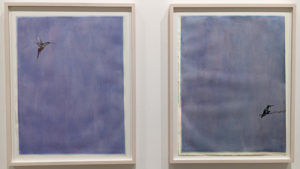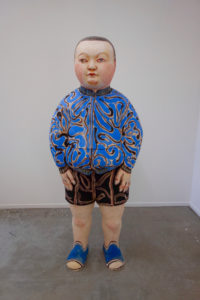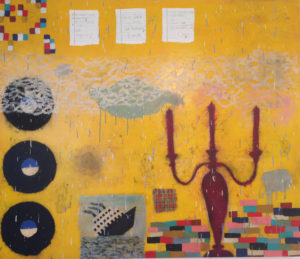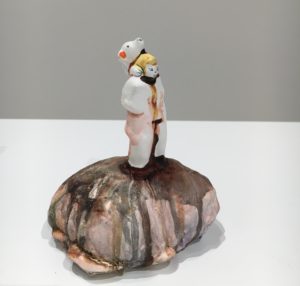September 1, 2016—October 8, 2016
James Harris Gallery is pleased to present “Unexpected Customs”, a group exhibition featuring painting, sculpture, and works on paper by artists Efrain Almeida, Squeak Carnwath, Claire Cowie, and Akio Takamori. The exhibition was created to demonstrate how artist practices are unique personalized visions; and through composition, and subject matter along with their use of color amplifies an object’s intent. Thus they share in a common custom. This show is also a response to a customs strike in Brazil trapping Efrain Almeida’s work in a state of limbo causing a delay of his solo exhibition until February 2017. The current show is “Unexpected” but through the viewers looking reveals an intensely personal experience created by works of art.
Unlike photography, painting is a transcription of human interaction with a surface. Squeak Carnwath’s paintings are ruminations on time, place, and human presence. Her iconography and use of color is a trigger for thoughts, memories and experiences. Through a combination of symbols, shapes and referential objects, Carnwath infuses her paintings with emotion and meaning. In the Painting “Our Reality,” Carnwath offers saturated colors in the forms of ovals, blocks, and dots combined with her signature vocabulary of records, candelabras, ships and hand written text to convey both bold exuberance and quiet reflection. These disparate forms become symbolic constructions for Carnwath’s meditations on the past, present and future. Drawn into the artist’s world, the viewer jumps or skips across the work into an attempt to piece together an elaborate cryptic narrative which refuses to offer a conclusive ending. Carnwath wants the viewer to make connections between words, objects and shapes; connections that often evoke moments of humor and sadness.
Sculpture is the core of Brazilian artist Efrain Almeida practice. Like most sculptors, the artist creates works on paper to explore ideas developed in his three dimension pieces. Almeida lyrically explores issues of sexuality, religion, nature, humanity and personal identity in his work. Hummingbirds have been a recurring an important psychological symbol in his practice for over 15 years. Humming Bird in Portuguese is “Beija Flores” translates to kiss flowers. Birds as a subject hold great meaning in art. They are symbols of freedom, of fragility, and transcendence. In the “Sky,” one hummingbird is depicted in flight while another sits waiting on a branch, their action separated yet united in composition, a fragile suspension of action. The artist purposely builds up the layers of color to create the blue hue of sky. Washes of blue and pink imbue the work with atmosphere and stillness. The detail of each bird appears to float against the minimalist sky.
Claire Cowie sees art as a communicative language. Her trademark watercolors and collages explore a personal iconography based on family, friends and experiences. In the past she has turned to sculpture to also depict these themes. In 2015, she created a body of work focusing on the idea of a traveller. In a sense we are all travellers through time. The sculptures reflect the human, fallible process of charting one’s progress and rectifying mistakes along the way. As in her previous work, animals often are stand-ins or foils for human figures. Washes of intense color are intuitively applied to emphasize form are countered by fine lines to articulate details. Each sculpture has its own narrative; placed together they create an open-ended dialogue of the psychology of the mind.
Akio Takamori’s freestanding sculptures investigate the interface between contemporary society and the flux of diverse global cultures that impinge on it. Takamori grew up in Kyushu, Japan and is a seminal figure working in the international ceramic arts for more than 30 years.. Bold form and color defines his body of work, which is highly expressive of human emotion, sensuality and fearless eroticism. He continues to explore the realm of human experience and rational social behavior through figures of youth and old age. Monumental in scale and personality, standing over six feet tall, “Boy” quietly engages the viewer. The sculptures size contradicts the innocence of his gaze. The bright blue jacket articulated with black lines intensifies the volume of form and his youthful appearance. The artist posits important questions about individual history and cultural perceptions.
The pieces selected for this exhibition remind us that nothing is static, choices are made and outcomes are determined. “Unexpected Customs” demonstrates personal journeys that we are welcome to join and add to our own experiences.
Efrain Almeida
Efrain Almeida is a sculptor using wood as well as bronze to create realistic sculptures that reference sexuality, religion, nature, humanity and personal identity on an intimate scale. He also uses the medium of watercolor to create works in conversation with his sculptural pieces. Almeida references his own history and memory of his home country of Brazil as well as the art historical canon. Almeida works on a small scale drawing the artist in and creating an intimate relationship between the viewer, the artwork, and the exhibition space. Almeida has had five solo exhibitions at James Harris Gallery, the latest show being “Trance” in 2017.
Almeida was born in the state of Ceará, in 1964. Currently, he lives and works in Rio de Janeiro. His most noteworthy exhibitions have included Marcas – a retrospective show concerning his work held in 2007 at Estaçăo Pinacoteca, in Săo Paulo – and his participation in the 2010 Bienal de Săo Paulo. His work figures in various public and private collections in Brazil and abroad, including those of the Museum of Modern Art, New York (USA), Museu de Arte Moderna de Săo Paulo, Săo Paulo (Brazil), Centro Galego de Arte Contemporânea, Santiago de Compostela (Spain) and Toyota Municipal Museum of Art (Japan).
Squeak Carnwath
Squeak Carnwath is a painter and printmaker who uses text, color field painting, and a wide variety of recognizable symbols to make interesting, engaging, and relatable works. Her works have the intimate feel of a diary, but acknowledge universal themes that are familiar to every viewer. Her paintings work together to form a kind of visual conversation within the spaces that they are displayed. Carnwath utilizes traditional painting techniques such as trompe l’oeil and symbolism, while also making statements that question the viewer’s thoughts and emotions. Carnwath wants the viewer to make connections between words, objects and shapes; connections that often evoke moments of humor and sadness. Carnwath currently lives and works in Oakland, California.
She has received numerous awards including the Society for the Encouragement of Contemporary Art (SECA) Award from San Francisco Museum of Modern Art, two Individual Artist Fellowships from the National Endowment for the Arts, a Guggenheim Fellowship and the Award for Individual Artists from the Flintridge Foundation. Carnwath is Professor Emerita at the University of California, Berkeley.
Claire Cowie
Claire Cowie uses a variety of media to reference the natural world around her home in Seattle, as well as around the world. Cowie utilizes symbols of the natural world such as birds, insects, and a variety of plant-life, as well as heavily using the negative space in a work. By using watercolor and ink in the areas around her subject Cowie references the fragmentation between the natural world and us, as well as of memory. The colors and shapes in her work create dream-like landscapes that pull in characteristics of urban architecture.
Claire Cowie lives and works in Seattle, Washington, where she is a lecturer at the University of Washington. Cowie attended both the North Carolina School of the Arts (Winston-Salem, NC) and Washington University in St. Louis (St. Louis, MO). She received her MFA from the University of Washington (Seattle, WA). Cowie’s work has been exhibited both nationally and internationally, including shows at the Henry Art Gallery (Seattle, WA), Takeda Biennial (Oaxaca, Mexico), Tacoma Art Museum (Tacoma, WA), Frye Art Museum (Seattle, WA), Shenzhen Art Institute (Shenzhen, China) and the Art Gym at Marylhurst University (Lake Oswego, OR). Her work is included in the collections of the Henry Art Gallery (Seattle, WA), Microsoft Corporation (Redmond, WA), Safeco (Seattle, WA), and Tacoma Art Museum (Tacoma, WA), among others.
Akio Takamori
Takamori was a seminal figure in ceramic art, whose work over the past thirty years has left an enduring impact on the Pacific Northwest arts and the medium itself. His work is often autobiographical, drawing on his life in Japan, his family, and mythological themes. He is known for his coil-built figurative sculptures in which the narrative painting defines the form. Takamori explored themes of cultural identity by engaging the history of Eastern and Western aesthetics. Bold form and color defines his body of work, which is highly expressive of human emotion and sensuality.
Akio Takamori was born and raised in Japan. He has been exhibiting in the United States, Europe and Asia since the mid 1980s. Takamori received his BFA from the Kansas City Art Institute in 1976 and his MFA from the New York State College of Ceramics, Alfred University in 1978.
Takamori’s work is included in numerous collections including the Nelson-Atkins Museum of Art in Kansas City, Los Angels County Museum of Art, Victoria & Albert Museum in London, Ariana Museum in Geneva, the Seattle Art Museum, and the Museum of Arts and Design in New York City. He is the recipient of numerous awards, including three National Endowment for the Arts Visual Artists Fellowship Grants (1986, 1988, 1992), the Joan Mitchell Foundation Painters and Sculptors Grant (2006), and the USA Ford Fellowship (2011). Takamori was a professor of art at the University of Washington. He lived and worked in Seattle.
Oil and Alkyd on canvas over panel
60" x 70"
Inquire about this work




